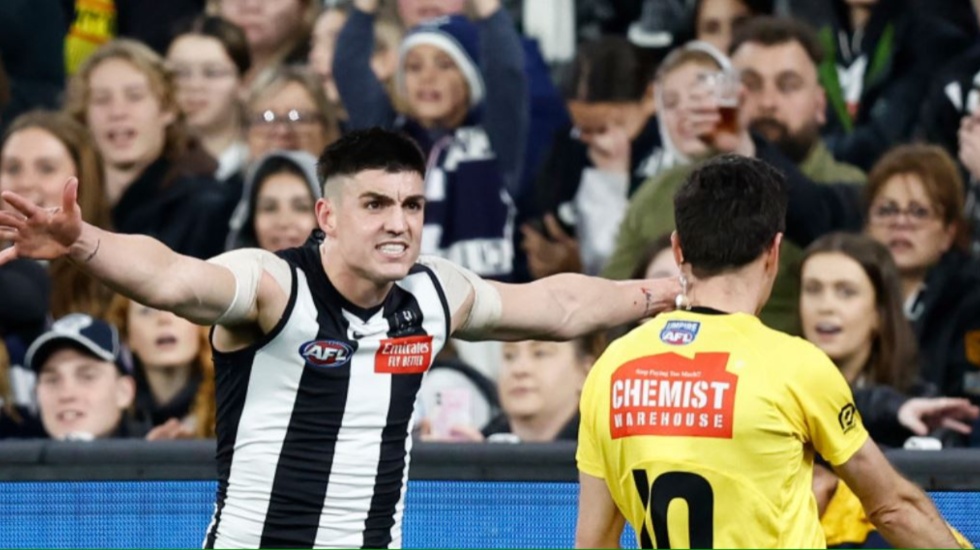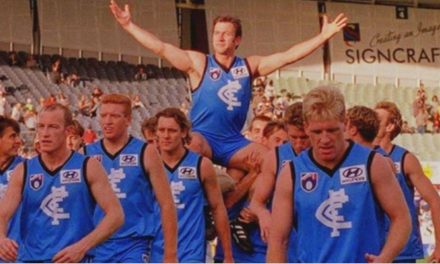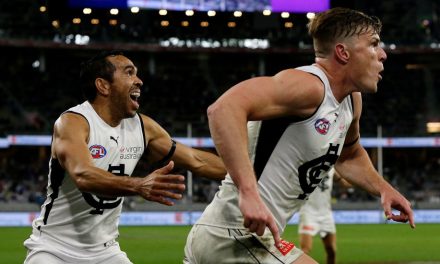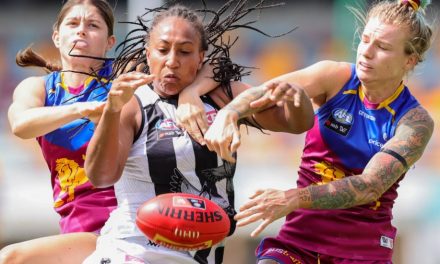Melbourne’s Jacob Van Rooyen has his legs taken from under him by Carlton’s Alex Cincotta. Picture: CHANNEL 7
Americans exposed to Australian football have often remarked that in Aussie Rules, the only rule is that “there are no rules”.
It sounds incredibly naive to those of us who grew up with the game and who know that, not only are there plenty rules, the AFL is forever adding to them And tweaking and redefining them.
Yet a visitor to the MCG last Saturday night could have been forgiven for adopting the “no rules at all” stance.
Consider that with less than three minutes left and the game in the balance, Melbourne forward Jacob Van Rooyen took possession near the boundary line in the forward 50. Carlton’s Alex Cincotta pitched himself towards Van Rooyen’s ankles and swept his legs from under him.
Little could demonstrate the hypocrisy of the AFL more than the fact nothing has been made of the umpire’s decision after that incident to settle for a boundary throw-in.
Hypocrisy? Yes, because despite all the talk about harmful tackles, the sanctity of the “noggin” and player welfare, Cincotta’s lunge went unpenalised despite its potential to cause serious injury.
Then Sydney star Dan Hannebery’s 2016 grand final ended when a below-the-knee lunge by the Western Bulldogs’ Easton Wood left him with a strained medial ligament. The difference in that case was that Wood actually won possession, and Hannebery’s leg was briefly trapped under Wood’s body.
Only luck ensured that something similar did not befall young Demon Van Rooyen. As Hannebery later remarked: “If both players are standing on their feet and someone gets hurt, that’s bad luck. But if someone slides in and chops the legs out, no matter who it is and no matter where it is, it has to be a free kick.”
In this instance, all four umpires ignored one of the oldest rules in the book, against tripping one’s opponent. Perhaps they also missed viewing the official AFL video about the ban on “forceful contact below the knees”.
There were many more such non-decisions on Saturday night, particularly those not rewarding the tackler for failure to properly dispose of the ball, which justifiably angered supporters of both teams at different times.
Max Gawn, too, was blocked off the ball as he strove to make one last marking contest in front of goal in the dying seconds. All in the spirit of “putting the whistle away” in a game of finals-like intensity.
But what really riled me was what happened at Marvel Stadium the following afternoon.
Consider the free kick which led to Max King’s fourth goal for St Kilda when his Saints took on the Tigers. It came from a simple contest with Richmond’s Dylan Grimes 24 minutes into the second quarter.
As King followed the ball’s flight, Grimes, approaching from an angle, made contact with an arm intended to impede King.
The contact itself was so fleeting that from one view it wasn’t discernible. From another angle, there was the merest hint of a jumper tug, but none of this would warrant a penalty in basketball. Yet it was paid a free kick, directly in front of goal near the goal square. Such a “gimme” the umpire could have kicked it himself.
But once you start examining umpiring inconsistencies, there are always more. Early this year, with the AFL determining dissent to an umpire’s decision was intolerable, a 50-metre penalty could be imposed for little more than a raised eyebrow. Certainly two arms held out in a “what was that?” gesture was a guaranteed penalty. Until it was not.
PLEASE HELP US CONTINUE TO THRIVE BY BECOMING AN OFFICIAL FOOTYOLOGY PATRON. JUST CLICK THIS LINK.
In the same round as the Van Rooyen and Grimes-King decisions, Collingwood’s Brayden Maynard performed a master class in dissent. Not without cause perhaps, after Geelong star Jeremy Cameron was awarded a mark seemingly taken about three rows of seats behind the fence.
Nonetheless, Maynard turned it on in various ways, an expression of disbelief in the immediate aftermath followed by an encore seasoned with outrage on viewing the replay. He even had teammate Nathan Murphy chime in with a supporting role. Back in autumn, this was a certain penalty. Not so now.

Collingwood’s Brayden Maynard disputes the mark awarded to Geelong’s Jeremy Cameron. Photo: AFL MEDIA
Carlton suffered multiple penalties for insufficient intent to keep the ball in play in those frenetic last minutes on Saturday. But a couple of weeks ago that rule appeared to have been shelved after several unfortunate decisions where players were penalised because the ball bounced awkwardly from a regulation kick downfield.
Surely everyone associated with the game knows the oval ball plays tricks. Had everyone forgotten the “Milne bounce” in the 2010 grand final?
After a series of over-zealous interpretations, it seemed “insufficient intent” underwent a rethink. At least last Saturday night it has to be said, the umpires had it right. But why so many rules of our game are from time to time deemed optional is the real issue.
It is not good enough to demand respect for the officials and yet allow the rules to be applied inconsistently. Other codes do not have this issue. Of course, if there were fewer rule changes from year to year, unforeseen consequences, and their subsequent adjustments, would be unnecessary.
The problem in part is the AFL’s multiple roles. It is the self-appointed guardian of the game, while simultaneously administrator of the game’s elite competition. As the game has professionalised on the back of television exposure, the AFL is also in the entertainment business with a product to sell. (The success of the Matildas, incidentally, will only increase the pressure on “the product”).
Among its guiding principles for the laws of the game the AFL states: “Continuous and free flowing football is encouraged ahead of repetitive short passages of play.”
This is where the AFL’s concerns around entertainment cut in, but it has meant long-held and well-understood rules about proper disposal of the ball are overlooked and the thing called “prior opportunity” is subject to regular rethinks. As is the old “hands in the back” rule. Keep this up and the game’s inherent credibility will be undermined.
The AFL needs to ask itself how it wants the game officiated and impose that standard, not shift it within seasons, or from week to week, or, as we saw last week, within the duration of a single round.
Surely, we should not accept games between teams with finals on the line being umpired differently. There should be one standard for all umpires to aspire to, at least. And instead of gagging comment on officiating, outright howlers need to be owned, publicly and openly, so a standard is recognised.
Ian Munro is the author of ‘Between The Flags – Making Sense or 57 Years of Heartache’ which covers the period from Melbourne’s golden era to its drought-busting 2021 premiership, including the impact of country zoning on the VFL. www.betweentheflags57.com.au












This is spot. The one factor you don’t discuss in AFL umpiring at the moment is “unconscious bias”. The umpires favour certain players eg Viney v Adelaide recently, Cameron receiving a handball out of bounds v Magpies, Danger often tackling others high with no consequence and The Bont getting 2 spins sometimes to dispose of the ball etc etc. How else can you explain the ranking of free kicks against with interstate teams at a significant disadvantage. No umpire is trying to be biased, they just can’t help it.
Not so. This from today’s Guardian. https://www.theguardian.com/sport/2023/aug/15/owen-farrells-rescinded-red-card-sets-worrying-precedent-for-the-game
Ian’s article is a biased opinion typical of a passionate AFL fan. However, I understand his passion and happen to support the opposing side, the bluebaggers. So, I’m sure he could respect my view as I do his. First, the Van Rooyen decision does have an element of grey. Cinncotta was attempting to smother while he was in the kicking action. Even though his legs were taken out and if a free was given, nobody would argue otherwise. But, it wasn’t as black and white as you mentioned. There isn’t a free kick given in the game for smothering while taking out the body. That play was open to interpretation. Also, Max Gawn’s block was straight out of Melbourne’s defensive playbook. Lever, May, Salem, Brayshaw, Rivers and Hibberd are the best in the competition at proving a block creating the double team. Now that small forwards are playing the same role, I don’t think you can call for umpires to take a stand. It’s a natural evolution of the game. Both forwards and defenders are expected to play a role for their team and get a body in the way. The third point about Max King receiving a goal for little interference which wasn’t sufficient to receive a goal, that’s again up the the men and women with the whistle and we don’t know what was happening leading up to the play. This year the AFL have moved more forward than in any other year by paying a 50 for descent. They’ve missed a few, like Maynard’s on Cameron’s mark on the boundary. Mind you, Maynard does give jumper punches and plays the poser tough guy. Nevertheless. the umpires are doing a fantastic job at following a pattern for teams to follow. Game plans are always going to push the rules, it’s part of our great game. People from outside of Australia that can’t follow the rules are not our target audience. It’s the Australian game and it’s more than just learning the rules to appreciate footy. It’s learning about Australian culture and the way we give a bloke a go. By the way, Carlton deserved to win on Saturday night, they played a better game and as Vossy said, got as rub of the green. But, Melbourne are a great team and will probably win the flag this year. Good luck my dees counterpart, I hope you can write an article about how umpires compliment our game. How they are the glue that holds the game together, not the ones that poorly influence results based on the momentum of play. Otherwise, give them a little credit at least for umpiring a unique game with rules not unlike basketball. In that game the hand is considered part of the ball. The Americans and European games are full of grey areas. The difference between them and our game is the way supporters can respectfully disagree. We don’t start riots, we don’t start fights, and we shouldn’t write articles asking for more. We have the greatest game in the world.
This is a workplace after all. For players and officials.
Incredibly frustrating for everyone involved.
If the AFL wants to be in the entertainment business, the best thing it can do is set the environment for a stable consistent product.
I.e. Keep the competition even with all teams being competitive. Keep the umpiring and rules of the game consistent, year in and year out. Pay the officials to be professional. Drop them when they’re not up to standard.
Make it a decent career option for people.
Tripping is Tripping. Pushing in the back is pushing in the back. Dropping the ball is dropping the ball.
It’s not interprative dance.
And for god’s sake, upgrade the ARC tech and get the process right for using it properly.
100% on the money! It also changes within game! The propensity of umpires to put the whistle away late in games I find incredibly frustrating, and typically results in rolling mauls making it incredibly difficult to score. I am a huge advocate for paying all free kicks at all times- as the great Leigh Matthews says – the game flows much better.